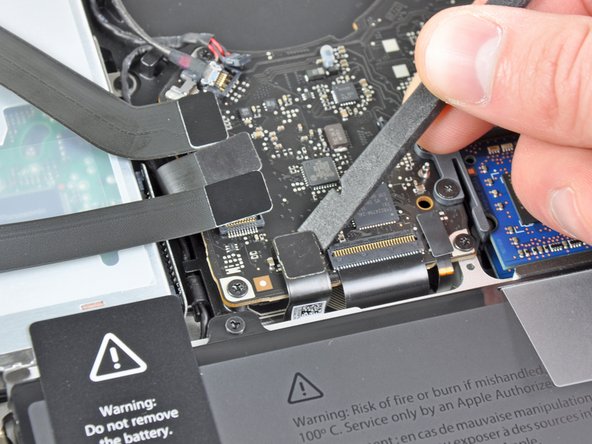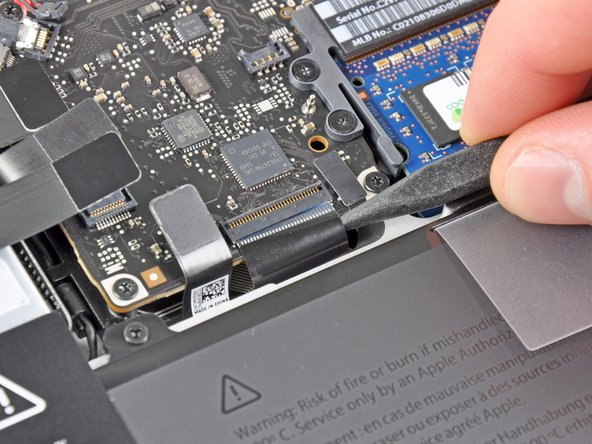Deze versie kan foutieve bewerkingen bevatten. Schakel over naar de recentste gecontroleerde momentopname.
Wat je nodig hebt
-
-
Verwijder de volgende tien schroeven:
-
Drie 14.4 mm lange Phillips #00 schroeven
-
Drie 3.5 mm lange Phillips #00 schroeven
-
Vier 3.5 mm lange geschouderde Phillips #00 schroeven
-
-
-
Gebruik de voor- of achterkant van een spudger om de batterijaansluiting uit het contact op het moederbord omhoog te wrikken.
-
-
Deze stap is niet vertaald. Help het te vertalen
-
Use the edge of a spudger to gently pry the fan connector up and out of its socket on the logic board.
-
-
Deze stap is niet vertaald. Help het te vertalen
-
Remove the following three screws securing the fan to the logic board:
-
One 7.2 mm T6 Torx screw
-
Two 5.3 mm T6 Torx screws
-
-
Deze stap is niet vertaald. Help het te vertalen
-
Lift the fan out of its recess in the logic board, minding its cable that may get caught.
-
-
Deze stap is niet vertaald. Help het te vertalen
-
Use the tip of a spudger to pull the right speaker/subwoofer cable out from under the retaining finger molded into the upper case.
-
Pull the right speaker/subwoofer cable upward to lift the connector out of its socket on the logic board.
-
-
-
Deze stap is niet vertaald. Help het te vertalen
-
Disconnect the following four cables:
-
AirPort/Bluetooth cable
-
Optical drive cable
-
Hard drive cable
-
Trackpad cable
-
-
Deze stap is niet vertaald. Help het te vertalen
-
Use your fingernail to flip up the retaining flap on the keyboard ribbon cable ZIF socket.
-
Use the tip of a spudger to pull the keyboard ribbon cable out of its socket.
-
-
Deze stap is niet vertaald. Help het te vertalen
-
If present, remove the small strip of black tape covering the keyboard backlight cable socket.
-
-
Deze stap is niet vertaald. Help het te vertalen
-
Use the tip of a spudger or your fingernail to flip up the retaining flap on the keyboard backlight ribbon cable ZIF socket.
-
Pull the keyboard backlight ribbon cable out of its socket.
-
-
Deze stap is niet vertaald. Help het te vertalen
-
Use the flat end of a spudger to pry the sleep sensor/battery indicator connector up from its socket on the logic board.
-
-
Deze stap is niet vertaald. Help het te vertalen
-
Grab the plastic pull tab secured to the display data cable lock and rotate it toward the DC-In side of the computer.
-
Pull the display data cable straight out of its socket on the logic board.
-
-
Deze stap is niet vertaald. Help het te vertalen
-
Remove the following nine screws:
-
Five 3.6 mm T6 Torx screws
-
Two 4.3 mm T6 Torx screws
-
Two 7.2 mm T6 Torx screws
-
Five 3.0 mm T6 screws
-
Two 3.6 mm T6 screws
-
Two 6.7 mm T6 screws
-
-
Deze stap is niet vertaald. Help het te vertalen
-
Remove the following two screws:
-
One 8.6 mm Phillips screw
-
One 5.5 mm Phillips screw
-
Remove the display data cable retainer from the upper case.
-
-
Deze stap is niet vertaald. Help het te vertalen
-
Use the tip of a spudger to gently peel the microphone off the adhesive securing it to the upper case.
-
-
Deze stap is niet vertaald. Help het te vertalen
-
Minding the many connectors near its edges, lift the logic board from the end nearest the optical drive.
-
Without flexing the board, maneuver it out of the upper case, minding the flexible connection to the DC-In board that may get caught in the upper case.
-
Remove the logic board.
-
-
Deze stap is niet vertaald. Help het te vertalen
-
De-route the microphone cable from its slot molded into the left speaker enclosure.
-
-
Deze stap is niet vertaald. Help het te vertalen
-
Remove the small piece of black tape covering the left speaker connector.
-
-
Deze stap is niet vertaald. Help het te vertalen
-
Use the flat end of a spudger to pry the left speaker connector up from its socket on the logic board.
-
-
Deze stap is niet vertaald. Help het te vertalen
-
Carefully pry the left speaker off the foam adhesive securing it to the logic board.
-
Remove the left speaker.
-
Annuleren: ik heb deze handleiding niet afgemaakt.
23 andere personen hebben deze handleiding voltooid.
4 opmerkingen
General - the reason you are reading this guide may well be that you blew you speakers after installing 'Boom' from the App Store.
All I can say is, don't install it a second time!
Others, be warned! If you use Boom, just use it at the lowest volume you can. Looks like they don't replace speakers.
Or better, don't install it at all.
Stuart.
You're right, Boom only enjoyable when using headphone, but it also kill internal speaker especially the mini internal subwoofer
You are right, but in my case it was VLC, I pushed the volume up to 200% and same result happened as you said of Boom, a speaker is blown.. LoL. So, same thing goes here, don't use VLC higher volume than 100%.
ottima guida
con un pò di pazienza si ottiene un ottimo risultato
grazie




































